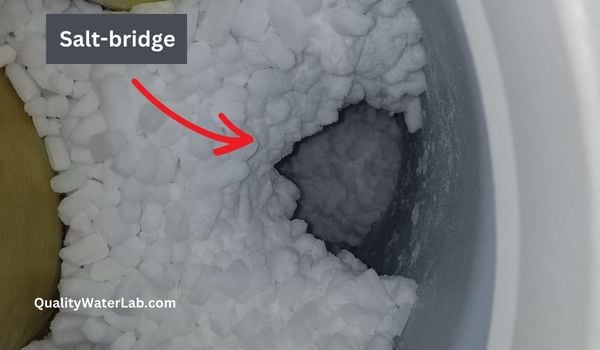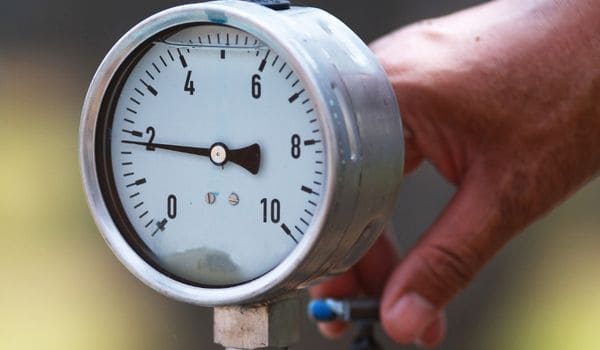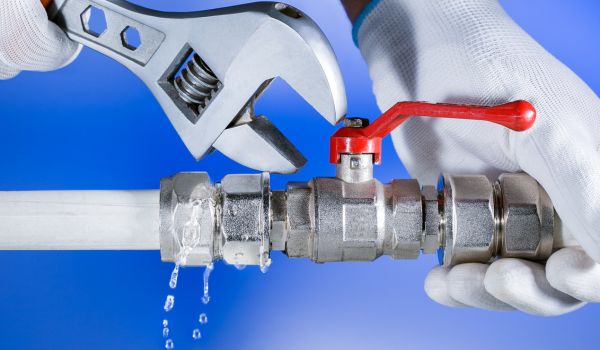If your water softener salt level never seems to drop, it’s a red flag — but don’t panic.
Most of the time, it’s something simple you can fix without calling a plumber. From salt bridges to stuck valves, we’ll help you track down the problem and get your softener working like it should again. If you’re curious about the science behind it, here’s a quick look at how water softening actually works.
Let’s troubleshoot it step-by-step.
🧠 Quick Takeaways
- ✅ Salt bridges and salt mushing are two of the most common causes — easy to fix once spotted. (If you’re overfilling the tank, it could cause bigger problems — here’s how to spot signs you’re using too much salt.)
- ✅ Wrong salt type or overfilling the tank can block proper brine production.
- ✅ Clogged parts like the Venturi valve or drain line can throw the whole system off.
- ✅ Low water pressure or bad settings can mess with salt usage behind the scenes.
- ✅ Catch early issues yourself — or call a pro if things look serious (like control valve failure).
🛠️ Main Troubleshooting Guide

| 🚩 Issue | 🔍 What’s Happening | ⚡ Quick Fix |
|---|---|---|
| 🧂 Salt Bridge | Hard crust forms above water, blocking proper brine making. | Break up bridge with broom handle; switch to high-purity pellet salt. Maintain indoor humidity below 50%. |
| 🌊 Salt Mushing | Slushy salt buildup at tank bottom clogs water flow. | Empty tank, clean out mush, refill with evaporated salt. Here’s a deeper guide on cleaning your water softener the right way. |
| 🧹 Clogged Venturi Valve | Debris blocking brine draw through injector. | Remove and clean parts gently with warm water and brush. |
| 🧪 Wrong Salt Type | Using table or rock salt instead of water softener salt. | Switch to evaporated or solar salt pellets for better dissolving. |
| ⚙️ Float Valve Misaligned | Float set too high or low, throwing off brine concentration. | Adjust float to recommended height in system manual. |
| 🚿 Clogged Drain Hose | Pinched, frozen, or blocked drain line disrupting cycle. | Clear hose or replace if damaged to restore flow. |
| 💧 Low Water Pressure | Not enough pressure to pull brine during regeneration. | Confirm 40–80 PSI household pressure; install booster pump if needed. |
| ⚙️ Incorrect Settings | Hardness or cycle settings entered wrong after outage or reset. | Recheck and adjust settings via control panel. |
| 🛠️ Component Failure | Worn-out valve, stuck pistons, or bad electronics. | Call pro for diagnosis and valve rebuild or system replacement. |
💬 Good to Know: Pelletized salt helps prevent both bridging and mushing. Keep your brine tank half full—never overfill it—to avoid recurring problems! Here’s more on how to spot and fix a salt bridge properly.
✅ Quick Tip: A salt bridge usually feels hard and hollow underneath when you tap it. Salt mushing feels like thick wet slush that doesn’t easily break apart. You can gently check with a broom handle or stick without damaging the tank.
💧 Low Water Pressure: A Hidden Salt Problem

Low incoming water pressure can sabotage your softener’s regeneration cycle. (Here’s what normal household water pressure should look like.)
| 🚩 Symptom | 🔍 Likely Cause | ⚡ Quick Fix |
|---|---|---|
| Low or no salt use | Incoming water pressure too low | Check pressure (target 40–80 PSI); install booster pump if needed. |
| Slow regeneration cycle | Clogged pre-filter or blocked plumbing | Replace filters; inspect piping for debris or buildup. |
| System stuck mid-cycle | Faulty pressure sensor or settings issue | Reset system; replace sensor if necessary. Also, here’s a refresher on how water softener regeneration works behind the scenes. |
🧐 Good to Know: If you’re on a well, pressure swings are more common depending on how fast your well water replenishes. It’s smart to monitor both softener cycles and your well’s recharge rate.
🛠️ Should You Hire a Pro?

If you’ve ruled out salt bridges, clogs, bad salt, settings, and pressure issues—but your softener still won’t use salt—it might be time to bring in help.
| When to DIY | When to Call a Pro |
|---|---|
| Minor salt issues (bridges, clogs, wrong salt) | Suspected valve, injector, or electronic failure |
| Water pressure is steady and normal | Water pressure issues linked to pumps or plumbing |
| System is newer (under 5 years) | Older systems or repeated failures |
👨👷 Pro Tip: Service calls usually cost $100–$200. If your softener is still under warranty, check before paying out of pocket!
🧠 Good to Know: If your softener is over 10–15 years old, the resin beads inside may start breaking down — which can cause salt problems that simple fixes won’t solve.
💭 Final Thoughts
If your water softener’s salt level isn’t dropping like it should, don’t panic. 90% of the time, it’s something easy you can troubleshoot yourself!
- ✅ Check the salt for bridging or mushing
- ✅ Inspect the nozzle, venturi, and brine line
- ✅ Confirm system settings are correct
- ✅ Monitor water pressure if things still seem off
Still stuck? No shame in calling a pro. Catching issues early keeps your water soft, your system healthy, and your wallet happy.
💧 Smart Move: A quick monthly peek at your salt level — and a light clean once a year — helps you catch small issues before they turn into expensive repairs.
 148 people found this helpful. Was this guide helpful to you?
148 people found this helpful. Was this guide helpful to you? 

